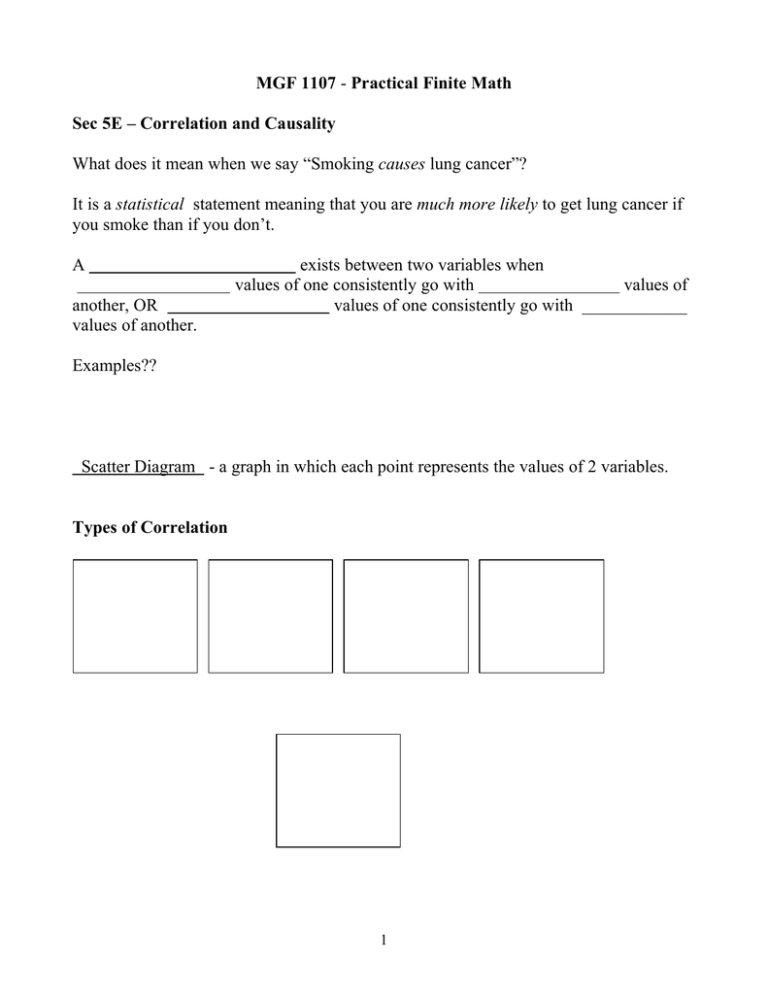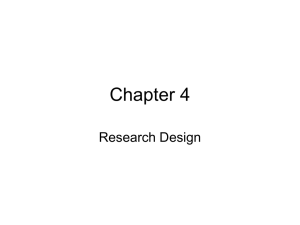MGF 1107 Sec 5E – Correlation and Causality causes
advertisement

MGF 1107 - Practical Finite Math Sec 5E – Correlation and Causality What does it mean when we say “Smoking causes lung cancer”? It is a statistical statement meaning that you are much more likely to get lung cancer if you smoke than if you don’t. A another, OR values of another. exists between two variables when values of one consistently go with values of values of one consistently go with ____________ Examples?? Scatter Diagram - a graph in which each point represents the values of 2 variables. Types of Correlation 1 Relationships Between Two Data Variables : There is no apparent relationship between the two variables. : Both variables tend to increase (or decrease) together. : The two variables tend to change in opposite directions, with one increasing while the other decreases. : The more closely two variables follow the general trend, the stronger the correlation (which may be either positive or negative). In a perfect correlation, all data points lie on a straight line. What sort of correlation would the following pairs of variables be likely to have? 1) Hours spent studying and Test grade. 2) Interest rate for home mortgages and Number of homes sold. 3) The price of apples and the inches of snowfall in Antarctica. Possible Explanations for a Correlation 1) The correlation may be a . 2) Both variables might be directly influenced by some . 3) One of the correlated variables may actually the other. (Note that, even in this case, we may have identified only one of several causes.) Which explanation for the correlation is most likely? 1) Professional golfers frequently have a higher instance of skin cancer. 2) Students who wore a hat scored higher on a test. 3) On a Friday in November, classes are cancelled after 1:25 and traffic is blocked on Tennessee Street. 2 (Read the Guidelines for Establishing Causality and scan the case studies. You won’t be tested on these guidelines.) How can we have confidence in causality? : We have discovered a correlation, but cannot yet determine whether the correlation implies causality. In the legal system, possible cause (such as thinking that a particular suspect possible caused a particular crime) is often the reason for starting an investigation. : We have good reason to suspect that the correlation involves cause, perhaps because some of the guidelines for establishing causality are satisfied. In the legal system, probable cause is the general standard for getting a judge to grant a warrant for a search or wiretap. : We have found a physical model that is so successful in explaining how one thing causes another that it seems unreasonable to doubt the causality. In the legal system, cause beyond a reasonable doubt is the usual standard for conviction. It generally demands that the prosecution show how and why (essentially the physical model) the suspect committed the crime. Note that beyond reasonable doubt does not mean beyond all doubt. Be sure you can/know: • What a scatter diagram is. • Distinguish between positive, negative, and no correlation between two variables. • The levels of confidence (possible cause, probable case, and cause beyond a reasonable doubt) • The levels of confidence with respect to legal issues. • How to identify the possible explanation for a correlation (coincidence, common underlying cause, cause) 3






